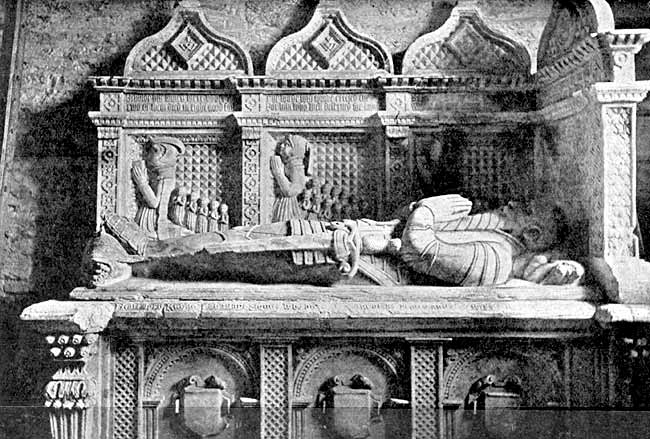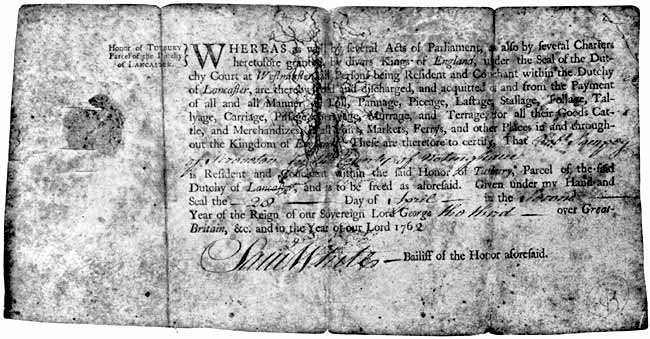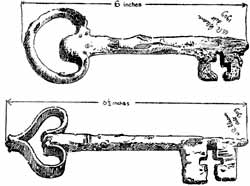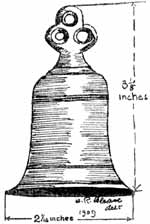In 1881, the following work was done on the chancel:— Gable built up with new coping and cross, new roof, new east window, and one new small lancet window on south side. Blocked-up archway in north wall opened out and new sacristy enclosing it and east window of north aisle of nave; new buttresses, and walls repaired generally where required ; new floor, of Minton tiles, with steps; new altar and rail; new oak stalls for two priests and choir.
In 1884, the north and south walls of the aisles, and the east wall of the south aisle were taken down and rebuilt from the foundations; the heads of the windows re-inserted with new mullions throughout; new roofs to nave and aisles, with red tiles; new door (made of old beams of nave roof) on north side; new porch on south side, replacing dilapidated one of red brick ; new buttresses throughout excepting tower buttresses ; new coping and cross ; nave and aisles re-seated.

Whalley Monument, Screveton Church.
The Whalley monument, now under the tower and formerly in the chancel, must not be forgotten. In his recent book, Mr. John T. Godfrey gives an accurate description and a good illustration of it.
The monument is a fine example of the splendid series of alabaster tombs in this and other countries. Two articles on this subject, dealing with the centre and extent of this industry, will be found in volumes X and LXI of the Archaeological Journal. The papers are written by Mr. Richardson and Mr. St. John Hope respectively. The trade from the Midlands with France has been indicated in Mr. W. Stevenson’s paper in volume XI of our Transactions. How far French examples may be English work can only be settled after a minute comparison of many English and French examples. A small volume published by the Lancashire Historic Society, on the Lydiate monuments, near Liverpool, gives illustrations of the separate panels. I would suggest the photographing of separate panels, as well as of complete monuments, as a better means of comparison and as a fair way to some definite conclusion.
Under the tower you will also find part of a tomb, which came from the south aisle (east end); part of a 15th century sepulchral slab, with incised cross on it; and a stone on the window cill with some late 11th century rope-work on it. Notice the old chest at the west end of the nave. It is unusually long and has two compartments. The lid of the left hand compartment has a slit in the centre of it, through which, centuries ago, many coins must have been dropped. The chest has ironwork fittings, and has apparently been worked out of one solid piece of wood; hence our use of the word “trunk” in the sense of “a portable box or chest.”
In the churchyard, notice the sundial; also the old yew tree, which consists of parent stem and daughter tree, the parent stem being shorn of its branches.
Not a few distinguished men have been more or less connected with Screveton, and of these, notices of Richard Whalley, the politician, Robert Recorde, the mathematician, Edward Whalley, the regicide, William Goffe, his son-in-law, Manners-Sutton, Archbishop of Canterbury, and George Christopher Hopkinson, the meteorologist and writer on education will be found in the Dictionary of National Biography. The last two were formerly rectors of Screveton.
As parcel of the Duchy of Lancaster, the inhabitants of Screveton were exempt from market and other tolls throughout the kingdom. As certificates of exemption in connection with this feudal privilege are rare, Mr. T. M. Blagg has kindly lent, for reproduction, his great-great-grandfather’s certificate.

Certificate of exemption.
Before leaving Screveton, members had the privilege of seeing a number of curios in the possession of Mrs. Bury. Besides the two already named, as belonging to Margidunum, the following items were on view:—two bronze kelts, a small iron axe, thought to be the top-piece of a helmet, a thurible, a sacring bell without tongue and with suspension rings, an umbo of a Danish shield, in a very crumbling state, a bottle stamp of wax, with I.W. on it; none of which could be located. The remaining two large keys were located ; the round handled one having been dug up in Screveton Churchyard in 1881, and the ogee-handled one in Chapel Close, Bingham. The latter possibly belonged to St. Helen’s Chapel, mentioned in Thoroton.
 |
 |
| Two large keys. | Sacring bells. |
As the party returned towards Car Colston, Brunsell Hall, a 17th century brick house, was inspected; permission to do so having been kindly granted by the present tenant, Dr. Laws, and the following paper was read there by Mr. T. M. Blagg.
(1) See Godfrey’s “Bingham Churches,” pages 387 and vii.
